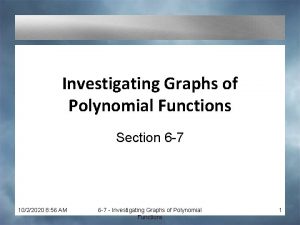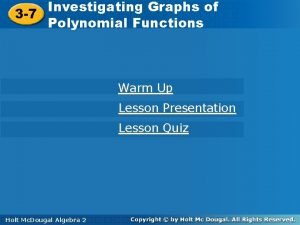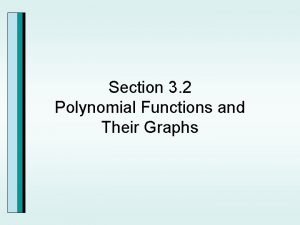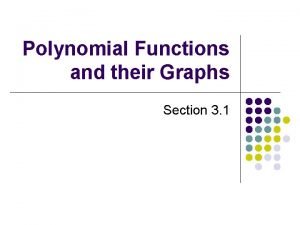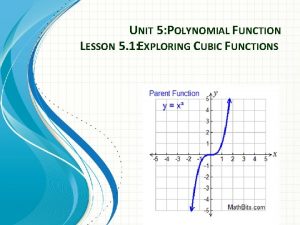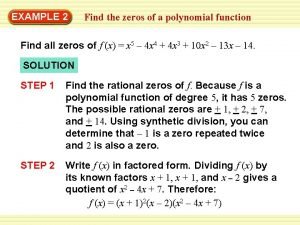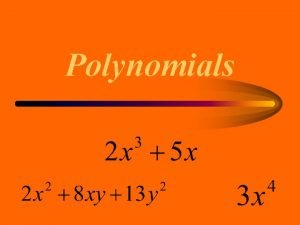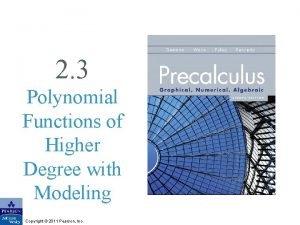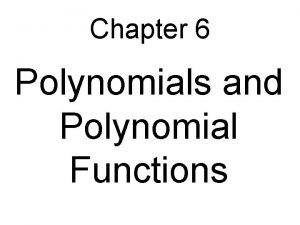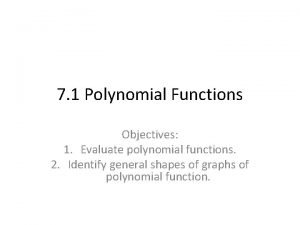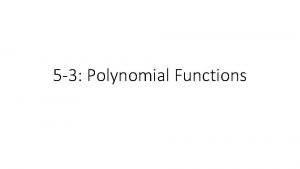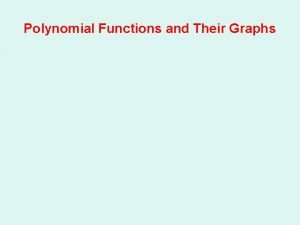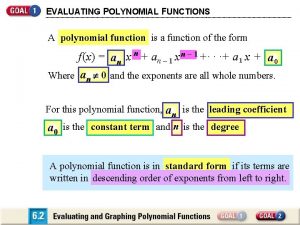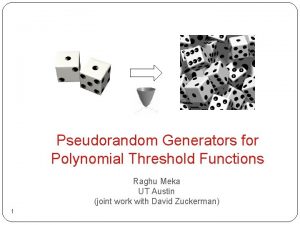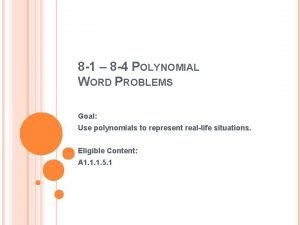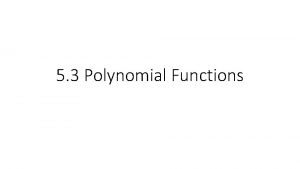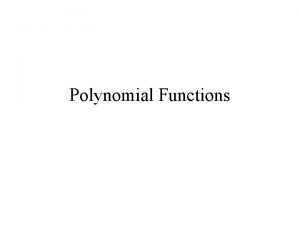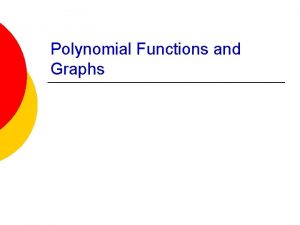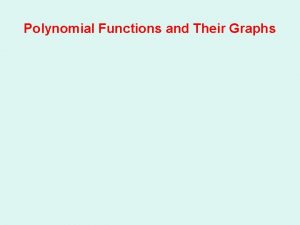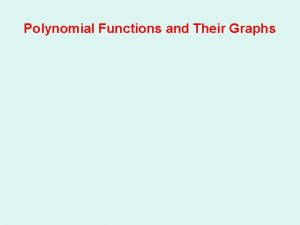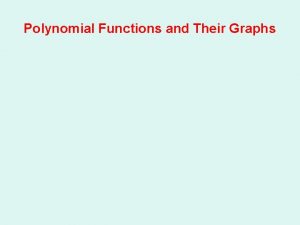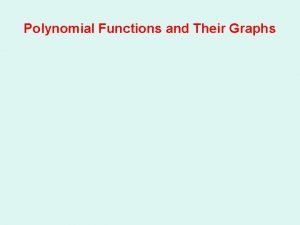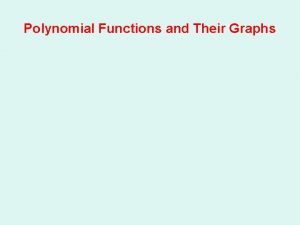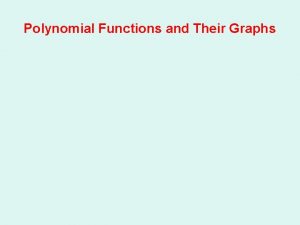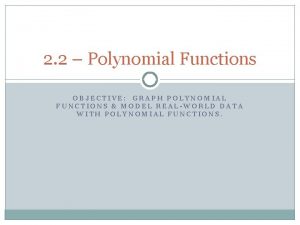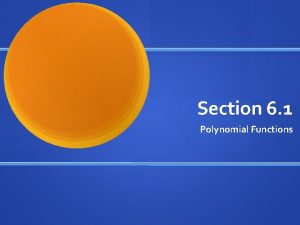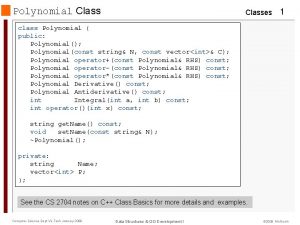Investigating Graphs of of Investigating Graphs Polynomial Functions




























- Slides: 28

Investigating Graphs of of Investigating Graphs Polynomial Functions Warm Up Lesson Presentation Lesson Quiz Holt Mc. Dougal Algebra 2 Algebra 22 Holt Mc. Dougal

Investigating Graphs of Polynomial Functions SAT Prep 10 minutes Only Holt Mc. Dougal Algebra 2

Investigating Graphs of Polynomial Functions Opening/Homework Review Pre-assessment Delta. Math Review 3 Holt Mc. Dougal Algebra 2

Investigating Graphs of Polynomial Functions Announcements Quiz Friday Due Friday CW- Matching CW- Factoring CW- Finding roots Deltamath will close Friday@11: 59 pm 4 Holt Mc. Dougal Algebra 2

Investigating Graphs of Notes: Functions Date: Polynomial Class: Textbook Reference: Review Points: 1) SWBAT MGSE 912. N. VM. 8 ADD, SUBTRACT, and MULTIPLY matrices of appropriate dimensions. 5 Essential Question: How can we represent data in matrix fo · When can we add and subtract matrices? Holt Mc. Dougal Algebra 2

Investigating Graphs of Polynomial Functions Warm Up Identify all the real roots of each equation. 1. x 3 – 7 x 2 + 8 x + 16 = 0 – 1, 4 2. 2 x 3 – 14 x – 12 = 0 – 1, – 2, 3 3. x 4 + x 3 – 25 x 2 – 27 x = 0 0 4. x 4 – 26 x 2 + 25 = 0 1, – 1, 5, – 5 Holt Mc. Dougal Algebra 2

Investigating Graphs of Polynomial Functions Objectives Use properties of end behavior to analyze, describe, and graph polynomial functions. Identify and use maxima and minima of polynomial functions to solve problems. Holt Mc. Dougal Algebra 2

Investigating Graphs of Polynomial Functions Vocabulary end behavior turning point local maximum local minimum Holt Mc. Dougal Algebra 2

Investigating Graphs of Polynomial Functions An degree of a polynomial is given by the term with the greatest degree. A polynomial with one variable is in standard form when its terms are written in descending order by degree. So, in standard form, the degree of the first term indicates the degree of the polynomial, and the leading coefficient is the coefficient of the first term. Holt Mc. Dougal Algebra 2

Investigating Graphs of Polynomial Functions Example 2: Classifying Polynomials Rewrite each polynomial in standard form. Then identify the leading coefficient, degree, and number of terms. Name the polynomial. A. 3 – 5 x 2 + 4 x B. Write terms in descending order by degree. – 5 x 2 + 4 x + 3 Leading coefficient: – 5 Degree: 2 Terms: 3 Name: quadratic trinomial Holt Mc. Dougal Algebra 2 3 x 2 – 4 + 8 x 4 Write terms in descending order by degree. 8 x 4 + 3 x 2 – 4 Leading coefficient: 8 Degree: 4 Terms: 3 Name: quartic trinomial

Investigating Graphs of Polynomial Functions Check It Out! Example 2 Rewrite each polynomial in standard form. Then identify the leading coefficient, degree, and number of terms. Name the polynomial. a. 4 x – 2 x 2 + 2 b. Write terms in descending order by degree. – 2 x 2 + 4 x + 2 Leading coefficient: – 2 Degree: 2 Terms: 3 Name: quadratic trinomial Holt Mc. Dougal Algebra 2 – 18 x 2 + x 3 – 5 + 2 x Write terms in descending order by degree. 1 x 3– 18 x 2 + 2 x – 5 Leading coefficient: 1 Degree: 3 Terms: 4 Name: cubic polynomial with 4 terms

Investigating Graphs of Polynomial Functions Polynomial functions are classified by their degree. The graphs of polynomial functions are classified by the degree of the polynomial. Each graph, based on the degree, has a distinctive shape and characteristics. Holt Mc. Dougal Algebra 2

Investigating Graphs of Polynomial Functions End behavior is a description of the values of the function as x approaches infinity (x +∞) or negative infinity (x –∞). The degree and leading coefficient of a polynomial function determine its end behavior. It is helpful when you are graphing a polynomial function to know about the end behavior of the function. Holt Mc. Dougal Algebra 2

Investigating Graphs of Polynomial Functions Holt Mc. Dougal Algebra 2

Investigating Graphs of Polynomial Functions Example 1: Determining End Behavior of Polynomial Functions Identify the leading coefficient, degree, and end behavior. A. Q(x) = –x 4 + 6 x 3 – x + 9 The leading coefficient is – 1, which is negative. The degree is 4, which is even. As x –∞, P(x) –∞, and as x +∞, P(x) –∞. B. P(x) = 2 x 5 + 6 x 4 – x + 4 The leading coefficient is 2, which is positive. The degree is 5, which is odd. As x –∞, P(x) –∞, and as x Holt Mc. Dougal Algebra 2 +∞, P(x) +∞.

Investigating Graphs of Polynomial Functions Check It Out! Example 1 Identify the leading coefficient, degree, and end behavior. a. P(x) = 2 x 5 + 3 x 2 – 4 x – 1 The leading coefficient is 2, which is positive. The degree is 5, which is odd. As x –∞, P(x) –∞, and as x +∞, P(x) +∞. b. S(x) = – 3 x 2 + x + 1 The leading coefficient is – 3, which is negative. The degree is 2, which is even. As x –∞, P(x) –∞, and as x Holt Mc. Dougal Algebra 2 +∞, P(x) –∞.

Investigating Graphs of Polynomial Functions Example 2 A: Using Graphs to Analyze Polynomial Functions Identify whether the function graphed has an odd or even degree and a positive or negative leading coefficient. As x –∞, P(x) +∞, and as x +∞, P(x) –∞. P(x) is of odd degree with a negative leading coefficient. Holt Mc. Dougal Algebra 2

Investigating Graphs of Polynomial Functions Example 2 B: Using Graphs to Analyze Polynomial Functions Identify whether the function graphed has an odd or even degree and a positive or negative leading coefficient. As x –∞, P(x) +∞, and as x +∞, P(x) +∞. P(x) is of even degree with a positive leading coefficient. Holt Mc. Dougal Algebra 2

Investigating Graphs of Polynomial Functions Check It Out! Example 2 a Identify whether the function graphed has an odd or even degree and a positive or negative leading coefficient. As x –∞, P(x) +∞, and as x +∞, P(x) –∞. P(x) is of odd degree with a negative leading coefficient. Holt Mc. Dougal Algebra 2

Investigating Graphs of Polynomial Functions Check It Out! Example 2 b Identify whether the function graphed has an odd or even degree and a positive or negative leading coefficient. As x –∞, P(x) +∞, and as x +∞, P(x) +∞. P(x) is of even degree with a positive leading coefficient. Holt Mc. Dougal Algebra 2

Investigating Graphs of Polynomial Functions Now that you have studied factoring, solving polynomial equations, and end behavior, you can graph a polynomial function. Holt Mc. Dougal Algebra 2

Investigating Graphs of Polynomial Functions Check It Out! Example 3 a Continued Step 5 Identify end behavior. The degree is odd and the leading coefficient is positive so as x –∞, P(x) –∞, and as x +∞, P(x) +∞. Step 6 Sketch the graph of f(x) = x 3 – 2 x 2 – 5 x + 6 by using all of the information about f(x). Holt Mc. Dougal Algebra 2

Investigating Graphs of Polynomial Functions Check It Out! Example 3 b Continued Step 3 The equation is in factored form. Factor: f(x) = (x + 2)(– 2 x + 3). The zeros are – 2, and 3 2 . Step 4 Plot other points as guidelines. f(0) = 6, so the y-intercept is 6. Plot points between the zeros. Choose x = – 1, and x = 1 for simple calculations. f(– 1) = 5, and f(1) = 3. Holt Mc. Dougal Algebra 2

Investigating Graphs of Polynomial Functions Check It Out! Example 3 b Continued Step 5 Identify end behavior. The degree is even and the leading coefficient is negative so as x –∞, P(x) –∞, and as x +∞, P(x) –∞. Step 6 Sketch the graph of f(x) = – 2 x 2 – x + 6 by using all of the information about f(x). Holt Mc. Dougal Algebra 2

Investigating Graphs of Polynomial Functions A turning point is where a graph changes from increasing to decreasing or from decreasing to increasing. A turning point corresponds to a local maximum or minimum. Holt Mc. Dougal Algebra 2

Investigating Graphs of Polynomial Functions A polynomial function of degree n has at most n – 1 turning points and at most n x-intercepts. If the function has n distinct roots, then it has exactly n – 1 turning points and exactly n x-intercepts. You can use a graphing calculator to graph and estimate maximum and minimum values. Holt Mc. Dougal Algebra 2

Investigating Graphs of Polynomial Functions Lesson Quiz: Part I 1. Identify whether the function graphed has an odd or even degree and a positive or negative leading coefficient. odd; positive Holt Mc. Dougal Algebra 2

Investigating Graphs of Polynomial Functions Lesson Quiz: Part II 2. Graph the function f(x) = x 3 – 3 x 2 – x + 3. Estimate the local maxima and minima of f(x) = x 3 – 15 x – 2. 20. 3607; – 24. 3607 Holt Mc. Dougal Algebra 2
 Investigating graphs of polynomial functions
Investigating graphs of polynomial functions 6-7 investigating graphs of polynomial functions
6-7 investigating graphs of polynomial functions Investigating graphs of polynomial functions
Investigating graphs of polynomial functions Investigating graphs of polynomial functions
Investigating graphs of polynomial functions End behavior chart
End behavior chart Polynomial functions and their graphs
Polynomial functions and their graphs Types of polynomials
Types of polynomials Structure in graphs of polynomial functions
Structure in graphs of polynomial functions 5-4 analyzing graphs of polynomial functions
5-4 analyzing graphs of polynomial functions 5-4 practice analyzing graphs of polynomial functions
5-4 practice analyzing graphs of polynomial functions Polynomial functions and their graphs
Polynomial functions and their graphs How to divide a polynomial by another polynomial
How to divide a polynomial by another polynomial Matplotlib inline
Matplotlib inline Types of polynomials
Types of polynomials Speed and velocity
Speed and velocity Zczc state graph
Zczc state graph Graphs that enlighten and graphs that deceive
Graphs that enlighten and graphs that deceive Lesson 5-2 graphing polynomial functions answers
Lesson 5-2 graphing polynomial functions answers Polynomial functions of higher degree with modeling
Polynomial functions of higher degree with modeling Factoring patterns
Factoring patterns Evaluate polynomial functions
Evaluate polynomial functions Sign of functions leading coefficient
Sign of functions leading coefficient Leading coefficient
Leading coefficient Evaluating polynomial functions
Evaluating polynomial functions What operations are polynomials closed under
What operations are polynomials closed under Polynomial expression standard form
Polynomial expression standard form Unit 5 polynomial functions homework 7
Unit 5 polynomial functions homework 7 Polynomial threshold functions
Polynomial threshold functions Polynomial word problem
Polynomial word problem

